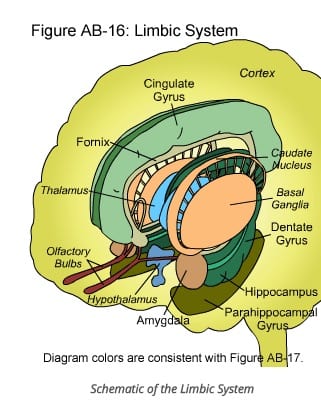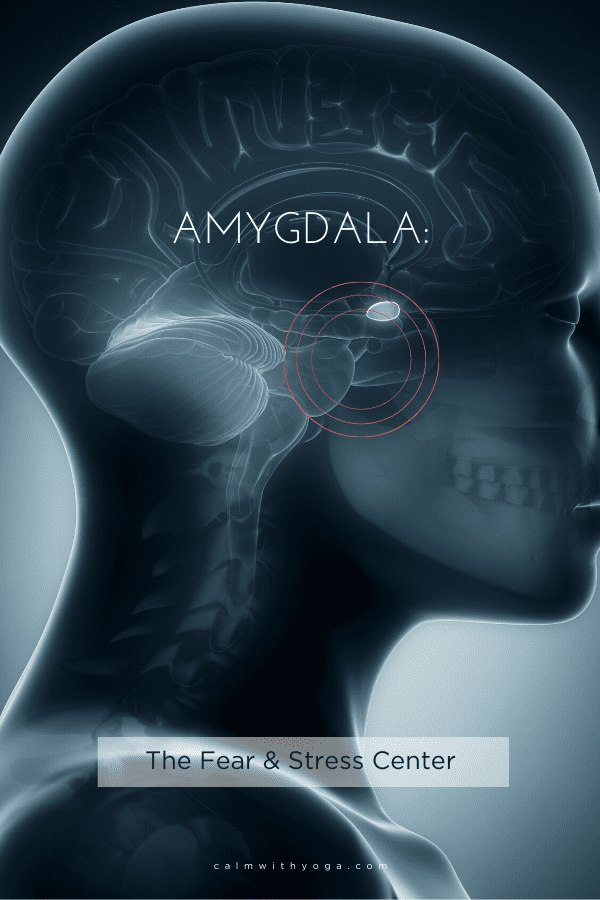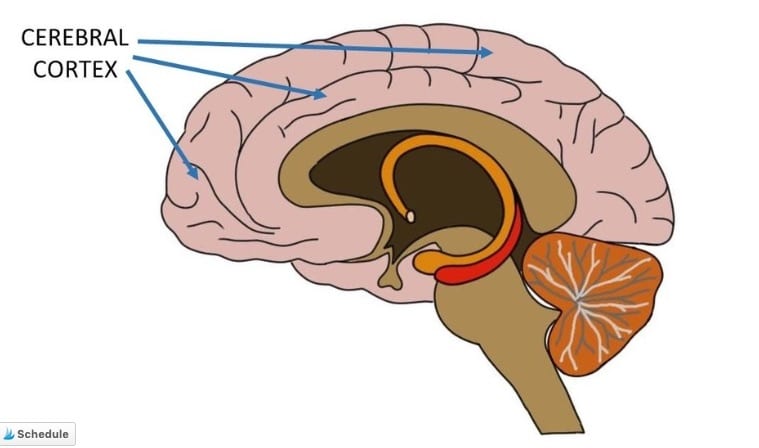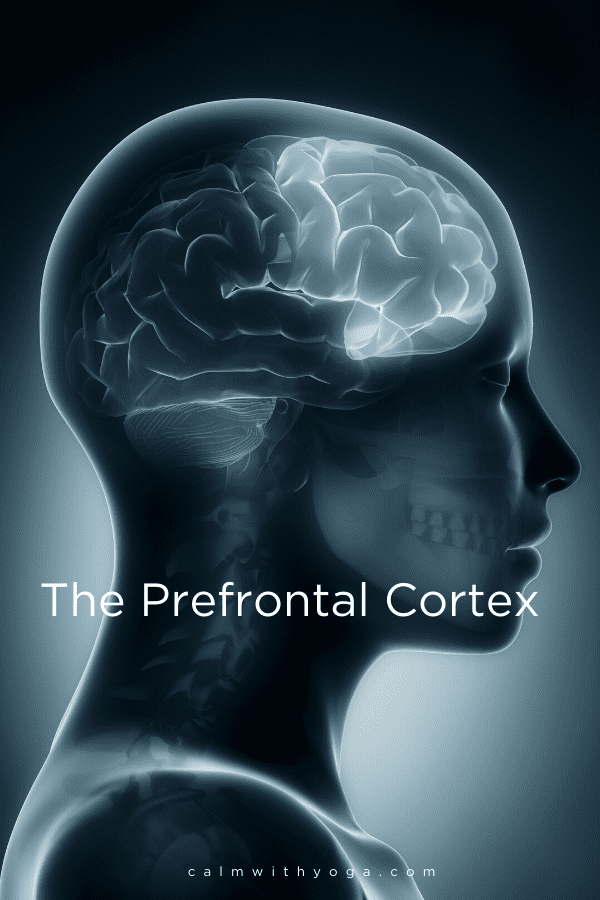– T.K. Coleman, educator It’s astonishing to think that this mass made up of over 86 billion neurons (brain cells) has been evolving over time and is comprised of three distinct brain structures or networks that emerged along the evolutionary path of humankind. According to the Triune Brain theory, these three distinct areas of the brain can be thought of as three brains in one:
1 – The Primitive Brain:
Known as the “Reptilian brain” oldest structure and it oversees our most basic functions like heart rate, body temperature, blood pressure, digestion, sleeping, and breathing rate. It is comprised of the brain stem – at the base of the head – and is connected to the spinal cord.
2 – The Emotional Brain:
Known as the Limbic system, this part of the brain oversees learning, memory, processing emotions, and activates the fight or flight response (stress response) in reaction to perceived dangers, painful situations, and threats. This network is found in the middle brain (underneath the cerebrum). The limbic brain controls emotions and influences the endocrine (hormonal) system and the autonomic nervous system. The following form part of the limbic system: Hippocampus: It helps us stay in the present moment by helping to convert short term memory into long-term memory. Hypothalamus: Interacts with the endocrine system (hormonal system) to maintain homeostasis (bodily balance). The hypothalamus works closely with the pituitary gland – an endocrine gland that regulates hormones such as stress hormones and oxytocin aka “the love hormone.” Thalamus: Acts like a two-way relay station processing and directing information from the spinal cord to the middle brain and up to the cerebrum and then from the cerebrum down the spinal cord to the nervous system. The Thalamus plays an important role in the information processing circuit related to your anxious thoughts and reactions. In this context, you can think of your Thalamus as a ‘switching station’ or a ‘filtering gate’ whose job is to distribute every bit of incoming information from the outside world. The Thalamus collects everything that your senses pick up from your environment, with the exception of your olfactory input – everything you see, hear, taste, and touch. (1) After receiving the signals from your eyes, ears, tongue, and skin it relays that information to both pathways, the cerebral cortex (the outermost part of the brain) and the amygdala. Cingulate gyrus: This area of the brain is involved in emotional processing and regulating behavior. Amygdala:
The amygdala (aka amygdaloid) is the almond-shape series of neural circuits located deep in the brain’s temporal lobe. Strong emotional experiences become your body’s emotional history. These emotional histories will condition how you feel and react to situations now. You can be operating like a split-screen, your rational or conceptual mind saying one thing and your feelings another because of stored emotional histories. – Doc Childre & Deborah Rozman, Transforming Anxiety: The HeartMath Solution for Overcoming Fear & Worry & Creating Serenity This part of the brain controls the pleasure/fear of reflexes and emotional responses. Various neuroimage fMRI studies (functional magnetic resonance imaging) reveal that damage to this brain region such as from a traumatic brain injury or illness can impact your decision-making so you’ll be more likely to take bigger risks with smaller potential gains. (1) Think of your amygdala as your very own built-in alarm system that will go off whenever it perceives a threat or potentially painful situation. It plays an important role in “defending” and keeping you safe and in your comfort zone too. It’s like an eavesdropper on incoming sensory information – when you experience a negative emotion the amygdala response is to sound the alarm to alert your hypothalamus. The amygdala keeps you stuck in the past. Your amygdala influences fear conditioning and emotional memory. An overactive amygdala will lead to a state of chronic fear-based reactions and the constant subconscious activation of your emotional memory bank. (2) It’s the birthplace of our emotional reactions and like a pavlovian dog, it conditions us to keep reacting in the same old ways and repeating the same old patterns. (Recipe for feeling frustrated, stuck, and overwhelmed, right?) The amygdala can literally hijack other brain processes. According to neuroscientist Joseph Ledoux, there are way more neural connections from the amygdala to the cortex (thinking brain) than vice versa (3) so it makes sense that we can’t think logically when the amygdala is sounding the alarm.
3 – The Thinking Brain:
Located in the outermost part of the brain called the cerebral cortex. This is the newest and most evolved part of our brain. These parts of the brain are what allows our prefrontal cortex to experience ‘thinking about our thinking’ and self-awareness.
It’s what allows us to move beyond knee-jerk impulses so we can experience imagination, inspiration, and creativity. The crowning achievement of this thinking brain is the frontal lobe which aids us in attaining higher awareness and more elevated states of consciousness.
The Effects of Stress On The Brain:
Stressful events are a non-negotiable part of life. In fact, the body is wired to withstand and even thrive in the midst of short-term stress. Unfortunately though, in today’s fast-paced world and daily life, most of us are experiencing ever-increasing stress levels and ever-rising cortisol (stress hormone) levels. The negative effects of chronic stress have been well documented. It’s becoming widely accepted now that stress causes health problems such as high blood pressure, heart disease, and even immune system dysfunction. Stress affects mental health too. Without proper stress management, it can turn into anxiety, panic disorder, or even post-traumatic stress disorder (PTSD). This is because over time stress changes brain function. Chronic stress really wreaks havoc on our minds. Stress can literally kill brain cells. A single stressful situation has the power to kill neurons in the brain’s hippocampus region (an area related to memory and emotion), as one animal study showed. (4) Chronic stress shrinks the brain, which leads to emotional and mental impairment. Specifically, stress shrinks the prefrontal cortex, which is associated with decision making, complex thinking, working memory, moderating social behavior, and attention control. (5) What’s worse, a chronically stressed-out brain becomes wired and predisposed to being in constant stress mode, thus creating a vicious cycle. Chronic stress not only shrinks the part of our brain associated with higher thinking, but it has also been shown to increase the size of the amygdala. (6) Since our amygdala is like our brain’s alarm system, sending distress signals whenever threats are perceived this isn’t a good thing for our mental health. This is why it’s so important to be proactive about managing your stress. Breathwork, meditation, and mindfulness have all been proven to help create more inner calm. REFERENCES : (1) https://www.scientificamerican.com/article/amygdala-loss-aversion/ (2) https://www.ncbi.nlm.nih.gov/pmc/articles/PMC3921083/ (3) LeDoux, Joseph, The Emotional Brain: The Mysterious Underpinnings of Emotional Life, 1996 (4) https://www.scientificamerican.com/article/stress-kills-brain-cells/ (5) https://www.sciencedaily.com/releases/2012/08/120812151659.htm (6) https://www.psychologytoday.com/us/blog/the-athletes-way/201311/the-size-and-connectivity-the-amygdala-predicts-anxiety





